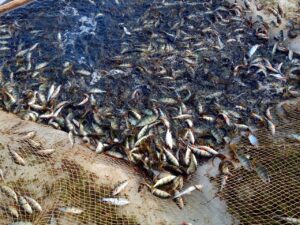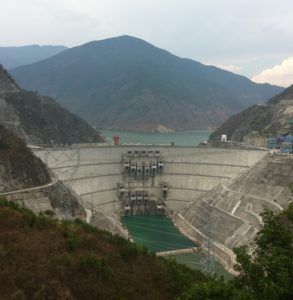Having just returned from Glasgow, Scotland, where I participated in the UN’s global climate conference known as COP 26, the blue economy was very much on display, and for good reason. The ocean covers 71% of the earth, absorbs over 90% of the excess heat caused by climate change, and acts as a carbon sink for 30% of human-induced carbon dioxide emissions and regulates the climate.
Yet coastal communities who rely on the ocean for their livelihoods and blue economies face growing risks from climate change. This is particularly true for Small Island Developing States (SIDS) and coastal nations in the Global South. At this COP, their leaders were more vocal on the topic than at previous meetings and they pushed for greater financial ambition and support from the developed world whom they see as responsible for the carbon build up over centuries.
But not all the global leaders from polluting nations came to Glasgow – Chinese President Xi and Russian President Putin opted out. This opened the door for the United States and Europe to fill the leadership void with new pledges, commitments and direct appeals to conference members who agreed for example to deep cuts in methane emissions. US Cabinet Secretaries and White House staff fanned out across COP in a show of force, proclaiming the US is back.
Yet many countries, stung by reversals during the Trump days, were skeptical. The issues of fairness and financial ambition were very much on display. Tensions were high on the topic, with developing countries calling on wealthy nations to double the amount of money they spend to help poor countries adapt to climate change by 2025. Their distrust was warranted, as wealthy nations, including the United States, had already failed to meet the $100 billion a year commitment that they had promised at previous COPs.
Unsurprisingly, a range of leaders, from Henry Puna, Secretary-General of the Pacific Islands Forum, and Simon Kofe, Foreign Minister of Tuvalu, to former US President Barack Obama delivered powerful speeches on the urgent need for immediate action, emphasizing the existential threat facing island communities, where climate change is not up for debate but is “a matter of survival.”
For decades climate leaders pushed mitigation first and adaptation and coastal resilience were relegated to a second tier. “Either or” scenarios are now outdated and outmoded with developing countries demanding more action and support. For example, in the leadup to COP26—in recognition of the urgent need for greater emphasis on adaptation—a coalition of developing countries called for a $1.3 trillion annual commitment from donor nations, split evenly between both mitigation and adaptation. As COP came to a close, India was asking for $1 trillion in global financial support, while a bloc of African nations was seeking $750 billion.
Experts agree the world needs to stay under 2 c. degrees with a goal of 1.5 c. degrees as set out in the 2015 Paris Agreement. Predictably, the issue of phasing out coal and fossil fuels to achieve these targets was center stage in Glasgow, with China and India’s climate teams pushing back on some of the more ambitious limits. However, there was positive news: the US and China made a surprising joint agreement to work together to cut methane pollution moving forward. However, equally important to these critical mitigation goals was a parallel discussion on the need to support the vulnerable communities grappling with climate impacts now—from sea level rise, forest fires, heatwaves, and drought, to increased storm intensity and devastating floods.
Developing nations argued that they still need to grow their economies and should not be punished for the carbon pollution that wealthier countries have spewed for centuries. Yet the pursuit of economic growth and sustainability need not be mutually exclusive endeavors. Developing coastal nations for example can build sustainable blue economies, use nature for protection from climate impacts, and raise funds to build resilience in their coastal communities at the same time.
There was much discussion on how to best employ nature-based solutions, from coral reef and mangrove conservation to restorative agricultural practices, to tackle the impacts of climate change. And nature-based solutions have garnered greater attention in the drafting of updated Nationally Determined Contributions (NDCs).
Wealthy developed countries heard the pleas from SIDS and coastal LDCs. President Biden pledged $11.4 billion annually to developing countries by 2024. The US government also announced a new program called “PREPARE” which will commit $3 billion in annual adaptation finance to countries most vulnerable to climate change. Similarly, the UK government launched a partnership with India to provide $50 million in annual funds to build climate-resilient infrastructure in SIDS. And at COP26, the EU pledged $115 million to the UN Adaptation Fund.
Another ongoing discussion at COP was that countries’ current National Adaptation Plans and NDCs are not adequate to meet future needs. Many fail to address both adaptation and mitigation, and it was suggested that several countries—needed to go back to the drawing board over the next year to improve the accuracy and efficacy of their plans.
The Stimson Center has developed a decision support tool, CORVI, which can aid coastal nations and SIDS as they develop more specific National Adaptation Plans. At COP, CORVI projects in Basseterre, St. Kitts and Nevis, Mombasa, Kenya, and Dar es Salaam, Tanzania were highlighted at three side events. The CORVI tool analyzes financial, political, and environmental risks to create coastal city risk profiles. With this knowledge, coastal communities are able to gain a more granular and holistic understanding of the specific risks they face from climate change. The information enables governments to enhance their national adaptation planning, take climate action, build resilience, and gain access to capital from international development organizations and financial institutions.
In addition to the CORVI side events, the UK’s Blue Planet Fund, in partnership with the Ocean Risk and Resilience Action Alliance (ORRAA), announced a project with Stimson and the Commonwealth Secretariat to pilot CORVI rapid assessments designed to build resilience in three SIDS.
At COP, former President Barack Obama said it best when he stated, “Those of us who live in big, wealthy nations — those of us who helped to precipitate the problem — have an added burden to make sure that we are…assisting those who are less responsible and less able but are more vulnerable to this oncoming crisis.”
With this backdrop, the scene has been set for COP 27 in Egypt. The plight and voices of the Global South will be even louder next year, and some nations will want to see the issues of losses and damages added to the conference table. With that drumbeat, countries and climate leaders must ensure that adaptation and mitigation gain equal footing, greater transparency is built into the overall process and wealthy nations uphold their financial commitments. In doing so, they will be able to build resilience where it is needed most and solve the inequities in the climate equation.



